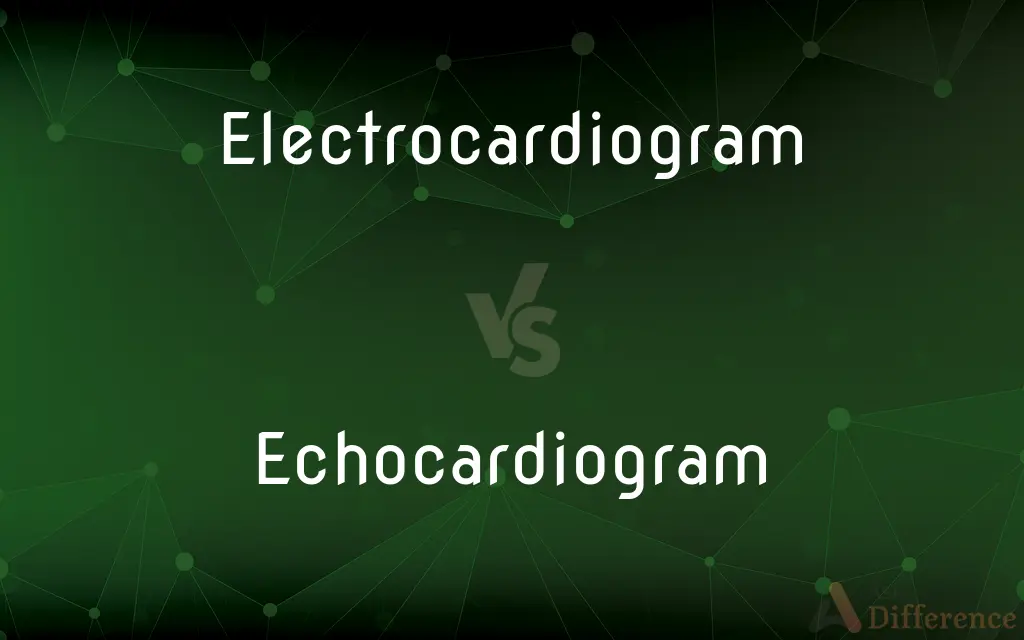Electrocardiogram vs. Echocardiogram — What's the Difference?
Edited by Tayyaba Rehman — By Maham Liaqat — Updated on April 18, 2024
An electrocardiogram (ECG) records electrical signals in the heart, indicating rhythm and electrical activity, while an echocardiogram uses ultrasound waves to produce images of heart structures.

Difference Between Electrocardiogram and Echocardiogram
Table of Contents
ADVERTISEMENT
Key Differences
An electrocardiogram (ECG) is a diagnostic tool that measures the electrical activity of the heart to detect heart problems by recording the timing and duration of each electrical phase in the heartbeat. On the other hand, an echocardiogram uses ultrasound technology to create images of the heart, providing visual insights into the structure and function of heart chambers and valves.
The ECG is essential for detecting arrhythmias, heart attacks, and other cardiac conditions related to the electrical function of the heart. Whereas, an echocardiogram is crucial for assessing physical abnormalities like problems with the heart valves, chambers, or muscle walls.
Electrocardiograms are typically quick, non-invasive, and performed using electrodes placed on the skin. Conversely, echocardiograms can be more involved, sometimes requiring a special probe placed in the esophagus or on the chest to get detailed images of the heart.
The results from an ECG can provide immediate data about the heart’s electrical activity, which is vital in emergency settings. On the other hand, echocardiograms give a comprehensive view of the heart’s anatomy and function, crucial for diagnosing structural heart diseases.
An ECG is often used in routine physical exams and in emergency settings to assess the heart’s rhythm and electrical activity quickly. In contrast, echocardiograms are used to monitor ongoing issues like heart murmurs, congestive heart failure, or infections of the heart tissue.
ADVERTISEMENT
Comparison Chart
Technology Used
Measures electrical activity
Uses ultrasound waves
Primary Function
Detects rhythm and electrical issues
Visualizes heart structure and function
Procedure Type
Non-invasive, uses skin electrodes
May require external or internal probes
Diagnostic Focus
Electrical activity and heart rhythm
Heart anatomy and mechanical function
Typical Use
Routine screenings, emergency analysis
Detailed evaluation of structural heart issues
Compare with Definitions
Electrocardiogram
A test that records the electrical signals in the heart to check for different heart conditions.
The doctor ordered an ECG to check for irregular heartbeats.
Echocardiogram
An ultrasound examination of the heart to view its structure and evaluate its function.
The echocardiogram showed that his heart valves were not functioning properly.
Electrocardiogram
Essential in diagnosing and monitoring heart rhythm disorders.
Her ECG revealed an underlying atrial fibrillation.
Echocardiogram
More detailed than an ECG in terms of anatomical assessment.
The echocardiogram provided a clear picture of the chamber sizes and wall thickness.
Electrocardiogram
Typically a fast and painless procedure.
The ECG was completed in just a few minutes during the consultation.
Echocardiogram
Can be performed at the bedside or in a specialized cardiology department.
The portable echocardiogram machine allowed for immediate examination in the patient’s room.
Electrocardiogram
Used widely in both hospital and outpatient settings.
He had an ECG during his routine health examination.
Echocardiogram
Often used in the management of patients with known or suspected heart disease.
Regular echocardiograms are part of his ongoing heart disease management plan.
Electrocardiogram
Provides data crucial for immediate clinical decisions.
Emergency teams use an ECG to quickly assess patients with chest pain.
Echocardiogram
Helps in diagnosing heart diseases like valve disorders, cardiomyopathy, and heart failure.
She underwent an echocardiogram to investigate the cause of her shortness of breath.
Electrocardiogram
A record or display of a person's heartbeat produced by electrocardiography.
Echocardiogram
A visual record produced by echocardiography.
Electrocardiogram
A graphic record of heart muscle activity recorded by an electrocardiograph.
Echocardiogram
The procedure performed to produce such a record.
Electrocardiogram
The procedure performed to produce such a record. In both senses also called cardiogram.
Echocardiogram
(medicine) The visual image formed by an echocardiograph.
Electrocardiogram
(cardiology) The visual output that an electrocardiograph produces.
Echocardiogram
An image of the heart produced by ultrasonography
Electrocardiogram
A graphical recording of the cardiac cycle produced by an electrocardiograph
Common Curiosities
What is an electrocardiogram?
An electrocardiogram is a medical test that records the electrical activity of the heart over a period of time using electrodes placed on the skin.
What conditions can an echocardiogram diagnose?
It can diagnose a variety of heart conditions, including heart valve diseases, heart failure, and congenital heart defects.
Can an ECG detect heart attacks?
Yes, an ECG can help detect heart attacks by showing changes in the heart's electrical activity.
What is an echocardiogram?
An echocardiogram is a type of ultrasound test that uses high-frequency sound waves to create images of the heart’s chambers, valves, walls, and the blood vessels attached to the heart.
How long does an ECG test take?
An ECG typically takes about 5-10 minutes to perform.
How do doctors choose between an ECG and an echocardiogram?
The choice depends on what the doctor is looking for; an ECG is used to check the electrical functioning, while an echocardiogram is used to assess structural and functional aspects of the heart.
What are the limitations of an ECG?
While ECGs are excellent for assessing the electrical functions of the heart, they do not provide information about the heart’s physical structures.
Is an echocardiogram safe?
Yes, echocardiograms are safe and non-invasive; there is no exposure to radiation.
Are there different types of echocardiograms?
Yes, there are several types, including transthoracic (standard), transesophageal (provides a closer look at the heart’s structures), and stress echocardiograms (assesses the heart under stress).
Can an echocardiogram detect blockages in the arteries?
An echocardiogram can indirectly suggest blockages by showing areas of the heart with poor blood flow, but it does not visualize the arteries themselves.
Share Your Discovery

Previous Comparison
Ireland vs. Irish
Next Comparison
Caliphate vs. SultanateAuthor Spotlight
Written by
Maham LiaqatEdited by
Tayyaba RehmanTayyaba Rehman is a distinguished writer, currently serving as a primary contributor to askdifference.com. As a researcher in semantics and etymology, Tayyaba's passion for the complexity of languages and their distinctions has found a perfect home on the platform. Tayyaba delves into the intricacies of language, distinguishing between commonly confused words and phrases, thereby providing clarity for readers worldwide.
















































